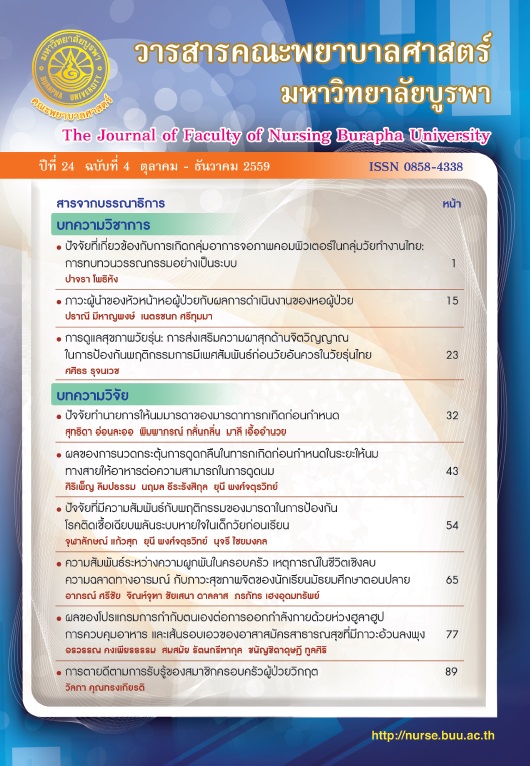ผลของการนวดกระตุ้นการดูดกลืนในทารกเกิดก่อนกำหนดในระยะ ให้นมทางสายให้อาหารต่อความสามารถในการดูดนม
คำสำคัญ:
การนวดกระตุ้นการดูดกลืน, ทารกเกิดก่อนกำหนด, ความสามารถในการดูดนม, Oral stimulation, preterm infants, feeding performanceบทคัดย่อ
บทคัดย่อ
การวิจัยครั้งนี้เป็นการวิจัยกึ่งทดลอง มีวัตถุประสงค์เพื่อศึกษาผลของการนวดกระตุ้น
การดูดกลืนในทารกเกิดก่อนกำหนดในระยะให้นมทางสายให้อาหาร กลุ่มตัวอย่างคือ ทารกเกิดก่อนกำหนดที่เข้ารับการรักษาในหอผู้ป่วยหน่วยบริบาลทารกแรกเกิด โรงพยาบาลสมเด็จพระบรมราชเทวี ณ ศรีราชา จังหวัดชลบุรี จำนวน 20 ราย สุ่มเข้ากลุ่มทดลองและกลุ่มควบคุม กลุ่มละ 10 ราย กลุ่มทดลองได้รับการนวดกระตุ้นการดูดกลืนในทารกเกิดก่อนกำหนดในระยะให้นมทางสายให้อาหาร ส่วนกลุ่มควบคุมได้รับการพยาบาลตามปกติของโรงพยาบาล เก็บรวบรวมข้อมูลระหว่างเดือนมีนาคมถึงเดือนสิงหาคม พ.ศ. 2557 เครื่องมือที่ใช้ในการวิจัย ได้แก่ คู่มือการนวดกระตุ้นการดูดกลืนในทารกเกิดก่อนกำหนดในระยะให้นมทางสายให้อาหาร แบบบันทึกข้อมูลทั่วไปของทารก แบบประเมินประสิทธิภาพการทำงานของกล้ามเนื้อในช่องปากของทารกแบบบันทึกปริมาณนมและแบบบันทึกระยะเวลาในการหัดดูดนม วิเคราะห์ข้อมูลโดยใช้สถิติพรรณนา และ Mann-Whitney U test
ผลการวิจัยพบว่า ภายหลังทารกคลอดก่อนกำหนดกลุ่มทดลองที่ได้รับการนวดกระตุ้นการดูดกลืนในระยะให้นมทางสายให้อาหารมีความสามารถในการดูดนมสูงกว่ากลุ่มควบคุมอย่างมี
นัยสำคัญทางสถิติ คือ กลุ่มทดลองมีประสิทธิภาพการทำงานของกล้ามเนื้อในช่องปากและปริมาณ
นมที่ทารกดูดได้ใน 5 นาทีแรกสูงกว่ากลุ่มควบคุม อย่างมีนัยสำคัญทางสถิติ (p < .01) และกลุ่มทดลองมีระยะเวลาในการหัดดูดนมน้อยกว่ากลุ่มควบคุม อย่างมีนัยสำคัญทางสถิติ (p < .01)
ผลการวิจัยครั้งนี้แสดงให้เห็นว่าการนวดกระตุ้นการดูดกลืนทารกเกิดก่อนกำหนดในระยะให้นมทางสายให้อาหารช่วยให้ทารกเกิดก่อนกำหนดมีความสามารถในการดูดนมเพิ่มขึ้น ดังนั้นพยาบาลและบุคลากรทีมสุขภาพควรนำการนวดกระตุ้นการดูดกลืนไปใช้ เพื่อส่งเสริมความสามารถในการดูดนมของทารกเกิดก่อนกำหนดให้ดีขึ้น เพื่อให้ทารกได้รับสารอาหารเพียงพอ มีภาวะโภชนาการที่ดี นำไปสู่การเจริญเติบโตที่เหมาะสม
Abstract
This quasi-experimental research aimed to examine effects of oral stimulation on tube feeding performances in preterm infants. Samples included 20 preterm infants receiving medical treatments at Sick new born unit and New born intensive care unit, Queen Savang Vadhana Memorial Hospital, Chonburi province. Ten preterm infants were randomly assigned to the experimental group and 10 preterm infants to the control group. The experimental group received oral stimulation during tube feeding whereas the control group received the usual nursing care. Data were collected since March to August 2014. The research instruments consisted of the Oral Stimulation Manual, the demographic questionnaire, the Efficiency of Oral Motor Function Questionnaire, the record of milk intake and the time to transition to oral feeding. Data were analyzed by descriptive statistics and Mann-Whitney U test.
Results revealed that after preterm infants in the experimental group received an oral stimulation during tube feeding, the feeding performance was significantly higher than those in the control group (p < .01). An efficiency of oral motor function scores and the milk intake in the first 5 minutes were significantly higher than those in the control group (p < .01). The transition time to oral feeding in the preterm infants in the experimental group was significantly lower than those in the control group (p < .01). These findings demonstrated that an oral stimulation in preterm infants during tube feeding can improve feeding performance. Therefore, nurses and healthcare team should apply an oral stimulation during tube feeding to enhance feeding performance in preterm infants in order to have sufficient nutrients which lead to an appropriate growth.





